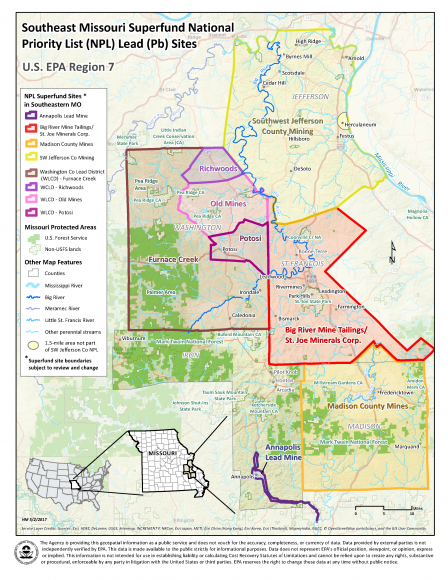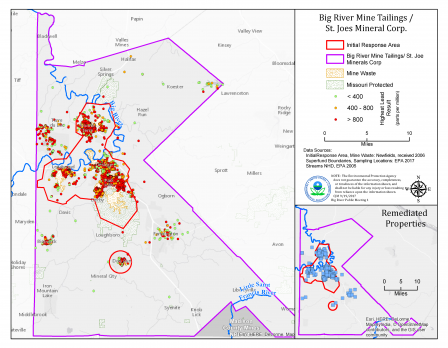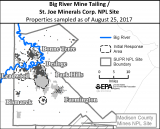Big River Mine Tailings National Priorities List (NPL) Superfund Site, St. Francois County, Missouri - Fact Sheet, October 2017
EPA Conducting Remedial Action for Residential Soils
OVERVIEW OF RESIDENTIAL SOIL CLEANUPS
 Southeast Missouri Superfund NPL Lead Sites Map - click to enlargeThe U.S. Environmental Protection Agency (EPA) is remediating (cleaning up) lead-contaminated soil in residential yards within the Big River Mine Tailings (BRMT) National Priorities List (NPL) Superfund Site in St. Francois County, Mo. Lead is the main contaminant of concern at this site. The NPL is a list of the nation’s hazardous waste sites with the highest priority for cleanup due to the greatest threats to human health and the environment. These sites are eligible for extensive, long-term response action money, as authorized by Congress under the Superfund Program.
Southeast Missouri Superfund NPL Lead Sites Map - click to enlargeThe U.S. Environmental Protection Agency (EPA) is remediating (cleaning up) lead-contaminated soil in residential yards within the Big River Mine Tailings (BRMT) National Priorities List (NPL) Superfund Site in St. Francois County, Mo. Lead is the main contaminant of concern at this site. The NPL is a list of the nation’s hazardous waste sites with the highest priority for cleanup due to the greatest threats to human health and the environment. These sites are eligible for extensive, long-term response action money, as authorized by Congress under the Superfund Program.
This site resides within the Old Lead Belt, which was one of the world’s largest lead mining districts where mining began in the early 1700s, having produced more than nine million tons of lead. (See map of Southeast Missouri Superfund NPL Lead Sites at right.) It has been estimated that some 250 million tons of hazardous mining waste (such as lead mill waste tailings and chat) were produced in the Old Lead Belt from processing lead ore.
Mining activities in St. Francois County have contaminated soil, sediment, surface water, and groundwater with elevated levels of heavy metals, primarily lead. Mine waste (chat) has been manually relocated throughout the area as topsoil, fill material, and aggregate for roads, railroads, concrete, and asphalt across the county. Lead mining tailings have also been used for agricultural purposes due to its lime content. Lead mining waste has also been transported downstream by the Big River.
EPA and Missouri state agencies have been addressing lead-contaminated soils in this county for over three decades.
RESIDENTIAL SAMPLING FOR LEAD
The county map (small version at left, and large version below), shows the site boundaries, area of the initial response, and the more than 4,700 residential properties that have been tested for lead contamination. Over 1,200 residential properties have been cleaned up since work began in 2000. Reports for these actions can be found at the site repository listed below.
 Click to enlargeEPA requests that property owners grant access to EPA’s contractor to test residential properties for possible lead contamination. If your property has not been tested, and you would like to have your soil and/or groundwater analyzed, please contact one of the EPA contacts listed below. This is at no cost to the property owner.
Click to enlargeEPA requests that property owners grant access to EPA’s contractor to test residential properties for possible lead contamination. If your property has not been tested, and you would like to have your soil and/or groundwater analyzed, please contact one of the EPA contacts listed below. This is at no cost to the property owner.
HOW WOULD EPA CLEAN UP MY PROPERTY?
If your residential property qualifies for cleanup, EPA will include an access agreement with your sampling results letter. By signing and returning the access agreement, you are taking the first step in the process to allow the EPA contractor to clean up the affected areas of your yard.
- The EPA contractor will schedule a time to meet with you, review the affected areas of the yard, answer any questions, and address any concerns. The contractor will have a checklist of items to discuss with you, including locating private utilities installed by you at the property and determining the best way to move equipment in and out.
- The EPA contractor will ask the owner to sign the checklist and give them final permission to start the work.
- Once utilities are located the cleanup can begin within a few weeks, weather permitting.
- The cleanup generally includes excavating up to one foot of soil from the areas that qualify for cleanup. If the property remains above the action level at one foot of depth, additional soil will be removed until lead concentrations are below the action level or down to 2 feet of depth, whichever comes first.
- The EPA contractor will then replace these areas with clean soil, return the grade to the original contours, and restore the lawn. Note: You are responsible for watering the growing lawn, which may result in additional cost to you on your water bill. This is the only expense you will bear throughout the process. The contractor is only permitted to restore the property to its original condition, and is required to repair or replace any items damaged during the cleanup process.
- Once the restoration work is complete and the yard is established, the EPA contractor will request a final meeting with you to review and sign a final checklist to confirm satisfactory completion.
LEAD CONTAMINATION HEALTH RISKS
Lead is a toxic metal that is harmful if inhaled or swallowed. It is classified by EPA as a probable human carcinogen and is a cumulative toxicant. Lead exposure can pose serious health risks, particularly for young children, pregnant women, and nursing mothers. Children are more sensitive to lead than adults, and can develop lifelong disabilities and problems from lead exposure. Children 7 years old and younger are most at risk from developing health effects from exposure to lead. It is important that children in this age range be tested annually, because lead-poisoned children do not always look or act sick. Talk to your pediatrician, general physician, or local health agency about what you can do and about testing your child. Your doctor can do a simple blood test to check you or your child for lead exposure. For free lead testing for children, contact the St. Francois County Health Center, at 1025 West Main Street, Park Hills, Mo., or by phone at 573-431-1947.
SITE REPOSITORY AND ADDITIONAL LEAD INFORMATION
The Administrative Records for the BRMT NPL Superfund Site are available online, where related Fact Sheets will also be posted. Additional site information is available at the following website: www.epa.gov/superfund/bigrivermine.
For more information about lead, visit:
EPA CONTACT INFORMATION
For questions or site information, please contact:
Lenexa, KS 66219
Lenexa, KS 66219
Email: kramer.elizabeth@epa.gov

